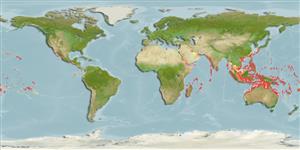Preferred temperature (Ref.
115969): 24.6 - 28.9, mean 27.6 (based on 846 cells).
Phylogenetic diversity index (Ref.
82804): PD
50 = 0.5000 [Uniqueness, from 0.5 = low to 2.0 = high].
Bayesian length-weight: a=0.03388 (0.01902 - 0.06038), b=2.85 (2.69 - 3.01), in cm Total Length, based on LWR estimates for this species & Genus-body shape (Ref.
93245).
Trophic level (Ref.
69278): 2.8 ±0.30 se; based on food items.
Resilience (Ref.
120179): Medium, minimum population doubling time 1.4 - 4.4 years (Fecundity = 400).
Fishing Vulnerability (Ref.
59153): Low vulnerability (10 of 100).
